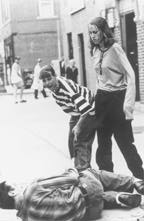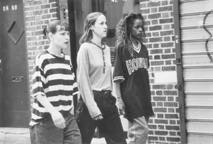Fighting the Power
Phyllis Belkin
By Rob Nelson
AS A VERITÉ portrait of adolescent life in the city, Girls Town won't get one-10th the hype of last year's Kids, even though it deserves to. The problem from a PR standpoint is that Girls Town doesn't tell an easily summarized fire-and-brimstone story about how our nation's youth have gone to pot--the sort of story that inspires so much op-ed handwringing and film-critic hyperbole.
More soulful than tough, and more hopeful than "realism" might otherwise dictate, Girls Town invests a palpable energy toward helping its three girl characters--and their counterparts in the real world--rediscover their self-esteem. The film suggests that getting pissed and even taking revenge can be constructive ways for a teenage female to deal with sexism. As the latest entry in the burgeoning genre of girl cinema (including compromised studio films like The Craft and Foxfire), it grants the catharsis and empowerment missing from Welcome to the Dollhouse. In so doing, Girls Town is the most unambiguously feminist American film to come down the pike in quite a while--another reason it might have trouble earning adequate press in some quarters.
Metroactive's interview with Lili Taylor.
Set in an unnamed city near New York (the movie was filmed in New Jersey), Girls Town carries only the faint outline of a plot. A few weeks before graduation at their high school, best friends Patti (Lili Taylor), Angela (Bruklin Harris) and Emma (Anna Grace) begin to test out methods of fighting the power after another member of their crew, the Princeton-bound Nikki (Aunjanue Ellis), commits suicide.
Where the girls of Kids got only those token scenes of dishing about sex before becoming one-dimensional prey, Girls Town is constructed entirely around improvised scenes of teen-girl conversation. The drama piles up gradually through the combination of these vignettes, which were scripted by the three lead actors and director Jim McKay (and co-writer Denise Casano) during extensive workshops prior to the shooting.
ULTIMATELY, the question of whether the girls will have to pay for their hard-won knowledge--for instance, by driving off a cliff--supplies a fair amount of tension, but this is hardly a typical Hollywood narrative. "If this was a movie," Taylor's tomboy Patti says at one point, "we woulda shot 50 people by now. We woulda been wearin' smeared lipstick and cryin' 'cause we don't know how to hold a gun."
Live Women Walking: Lili Taylor (left), Anna Grace (middle) and Bruklin Harris stride purposely through the mean streets of "Girls Town."
Instead, the friends, after discovering that Nikki had been sexually assaulted by her boss, impulsively decide to demolish a car belonging to another creep, a boy who date-raped Emma. While the school band plays a pep rally in the background, the girls spray paint "RAPIST" on the hood of the kid's Cadillac, and then immortalize their triumph on a bathroom stall--including the drawing of a car, the words "Subvert the Patriarchy" and ample space below for girls to write in the names of other rapists.
The strike-back feels liberating to this distaff posse, and even addictive. They proceed to steal CDs and stereo equipment from Patti's abusive ex-boyfriend (John Ventimiglia) and trade them for cash at a pawn shop, and they confront Nikki's attacker (Tom Gilroy) at his place of work.
A mainstream movie might have bent this material into a didactic "Just Say No" tract or at least a moral dilemma about whether this is the proper way for girls to resolve their problems (any guesses as to what it would have concluded?), but Girls Town leaves it up to the viewer to decide.
The main reason the film can afford to take such an approach is that it owes little to the sensibilities of industry bean-counters. Financed out of pocket by McKay and auteur-producer Lauren Zalaznick (Kids, Safe), Girls Town was shot in 16mm in a mere 12 days--the speed of production no doubt enhancing the spontaneous vibe on the screen (McKay has professed admiration for John Cassavetes and Frederick Wiseman) but also ensuring that a script about teen-girl solidarity in the face of rape, devoid of hasty uplift, would get made at all.
Such are the glossy standards even of "independent" filmmaking these days that producing a film this cheaply, without including marketably sensational elements like sex jokes (Clerks) or guns (nearly any urban drama post-Tarantino), is practically a subversive act. And the DIY aesthetic is central to the movie's themes. Not for nothing does the film return repeatedly to the girls' graffiti-filled bathroom stall, their no-budget work of agitprop gradually inspiring more schoolgirls to express themselves.
OF ITS THREE diverse heroines, Girls Town primarily takes after the levelheaded Emma, an aspiring journalist who volunteers at a women's shelter, and who gives an autobiographical speech in class about the importance of "seeing what's going on in the world and then communicating your perspective on it."
At the same time, the film understands Angela's annoyance with "people who get in my business" and Patti's impractical dream to "win the lotto and get the hell out of this fuckin' town."
Taylor's thoroughly believable performance--a hyperadrenalized mix of rage, sudden blushes and playfully vulgar invectives--helps the movie maintain its spirit of buoyant optimism and compliments the quiet introspection of Grace's Emma and the angry resilience of Harris's Angela.
Another of the film's unique elements is its vision of a racially integrated girls' clique--a deliberate tactic the New York Times' reviewer saw fit to interpret as a weakness, supposedly because "the ease with which [the] friendships transcend ethnic and class boundaries seems more fantasy than fact." Maybe so, but this quality reflects the movie's intent to communicate to adolescents rather than about them, and its emphasis on providing inspirational models of behavior instead of defeatist sorts of truth. The unfashionable greatness of Girls Town stems from its belief that being real isn't enough these days.
[ Metro | Metroactive Central | Archives ]
This page was designed and created by the Boulevards team.

Fighting Back: Lili Taylor (left) and Anna Grace fight back against one of their many male tormentors in director Jim McKay's "Girls Town."
More soulful than tough, Jim McKay's bracing new film, 'Girls Town,' gives three teens a chance to get pissed and strike back![[line]](/gifs/line.gif)
![[line]](/gifs/line.gif)

Phyllis Belkin
Girls Town (Rated R; 90 min.), directed by Jim McKay, written by McKay, Denise Casano, Anna Grace, Bruklin Harris and Lili Taylor, and starring Taylor, Grace and Harris.
From the August 29-September 4, 1996 issue of Metro
![[Metroactive Movies]](/movies/gifs/ma-movies.gif)